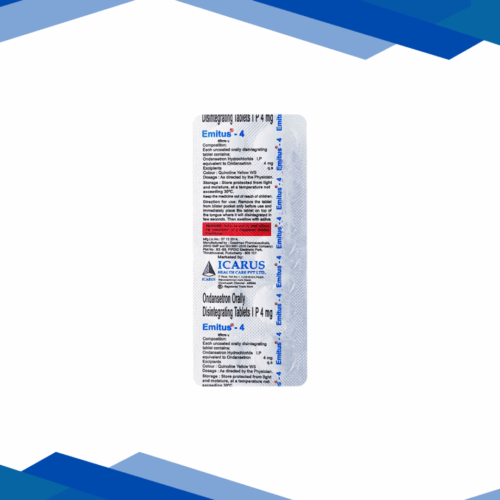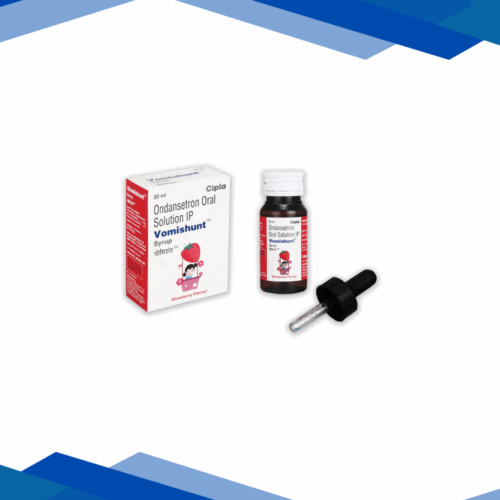Ondansetron
ONDANSETRON
Overview:
Ondansetron is a medicine used to prevent and treat nausea and vomiting caused by chemotherapy, radiation, surgery, or stomach problems.
It is available in tablets, syrups, and injections.
Classification:5-HT₃ (serotonin) receptor antagonist
Uses:
Ondansetron is prescribed to prevent and manage nausea and vomiting linked to chemotherapy, radiation therapy, post-surgical recovery, and stomach infections such as gastroenteritis. It can also be administered for pregnancy-related vomiting, but only under medical supervision. This drug is particularly beneficial when nausea is intense or when other treatments are ineffective.
How it works:
Ondansetron functions by inhibiting serotonin (5-HT₃) receptors located in both the brain and the digestive system.
Serotonin is a substance that can initiate the vomiting response.
By obstructing these receptors, ondansetron aids in preventing and alleviating nausea and vomiting, particularly those induced by chemotherapy, surgical procedures, or gastrointestinal illnesses.
Dosage:
As prescribed by your doctor.
Side effects:
Headache
Constipation
Dizziness
Tiredness or fatigue
Dry mouth
Precautions:
Before initiating Ondansetron treatment, it is crucial to inform your healthcare provider if you have any liver diseases, heart conditions, or a history of irregular heart rhythms. This medication requires careful use in individuals with low levels of potassium or magnesium in their blood. It is advisable to avoid taking it in conjunction with other medications that may impact heart rhythm. Pregnant or breastfeeding women should only use Ondansetron if it is explicitly prescribed by a doctor. Always follow the prescribed dosage and avoid using it for mild or occasional nausea without consulting a healthcare professional.
Disclaimer:
This content is for informational purposes only. Always consult a healthcare provider for medical advice and proper dosage.
Pantoprazole
PANTOPRAZOLE
Overview:
Pantoprazole is a drug that reduces acid levels produced in the stomach. It belongs to the category of the drug blockers called proton pump inhibitors (PPIs). The drug has often been used to treat acid reflux, gastroesophageal reflux disease (GERD), stomach ulcers and Zollinger-Ellison syndrome. Pantoprazole relieves such symptoms as heartburn and helps to recover the stomach lining.
Classification:Proton Pump Inhibitor (PPI)
Uses:
Pantoprazole is used to treat the diseases caused by an excess stomach acid like GERD (gastroesophageal reflux disease), acid reflux, stomach ulcers, and the Zollinger-Ellinson disease. It also relieves the symptoms of heartburn, acid regurgitation, and indigestion, by reducing acid secretions and helps in recovering the stomach and the esophagus.
How it works:
Pantoprazole acts in blocking a pump on the stomach lining called proton pump (H 16 itrapazoviatricfootnote 16 overnight hist seriously atpase). This is an enzyme that has a key role in producing stomach acid. Pantoprazole reduces the acid content of a stomach by stopping the action of this pump. Such a decrease aids in improving the symptoms of heartburn and repairing the injured parts of the stomach and esophagus.
Dosage:
As prescribed by your doctor.
Side effects:
Gas or bloating
Stomach pain
Headache
Nausea or vomiting
Diarrhea
Precautions:
Prior to taking pantoprazole, inform your physician about your liver conditions, low levels of magnesium, and any other drug that is in use that can react with this. Side effects of long-term use include vitamin B12 deficiency, loss of bone, or intestinal infection. Pregnant/ Breast feeding: use with caution, only with medical advice. Nevertheless, do not eliminate the medicine abruptly, at least, without the doctor consultation, particularly in a case of long-term treatment.
Disclaimer:This content is for informational purposes only. Always consult a healthcare provider for medical advice and proper dosage.

















